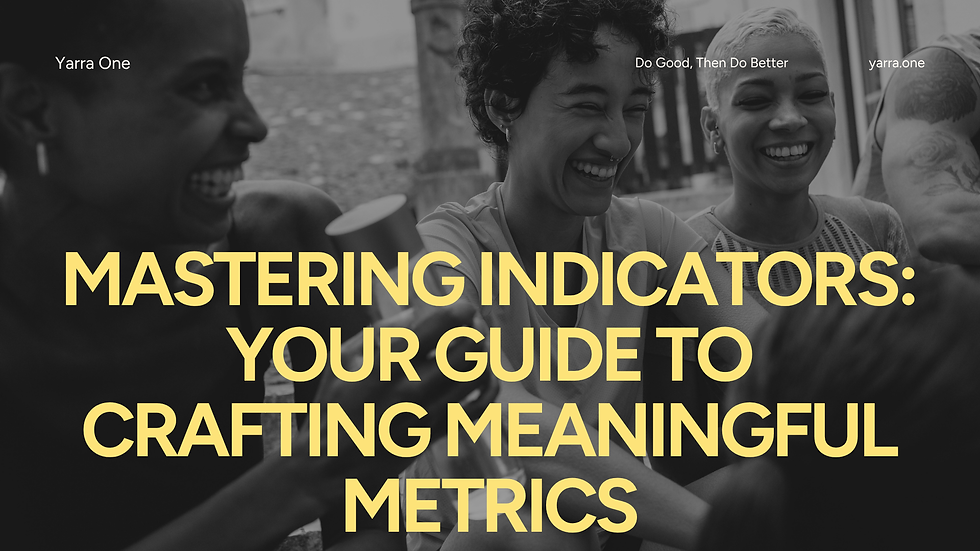Mastering Indicators: Your Guide to Crafting Meaningful Metrics
- Victor Hijzen
- Jun 12
- 4 min read
Ready to transform how you measure impact? Effective metrics are crucial for making a difference in any field, as they help track progress and guide decision-making. In this guide, we'll explore how to create indicators that are both smart and actionable, using Time Management as an example. By following these clear, practical steps, you’ll be able to craft indicators that truly shine.

1. Define Your Concept
Before you can measure anything, you need to nail down what you're measuring. Think of this as your concept's blueprint. For our example, time management, you need to define what this concept actually includes.
Bad Example: Time Management is simply “keeping track of time.” This vague definition lacks clarity and fails to specify what aspects of time management are important.
Good Example: Time Management includes three key elements:
Prioritisation (how you decide which tasks to tackle first),
Execution (how well you follow your schedule), and
Evaluation (how you adjust your strategies based on what’s worked in the past). This clear breakdown ensures a comprehensive understanding of the concept.
Tip: Clearly outline the concept and identify its core components. This sets a solid foundation for developing effective indicators. If your concept has too many core components, simplify it to focus on 3 to 5 key areas.
2. Identify Measurable Elements
With your concept defined, it’s time to drill down into each element you’ll measure. For Time Management, you’re focusing on three distinct parts. Here’s how to break them down:
Bad Example: For Time Management, you list broad categories like "planning" and "organisation," without specifying how to measure them.
Good Example: For Time Management, break it down into measurable elements:
Prioritisation: How you rank tasks by urgency and importance.
Execution: How closely you follow your planned schedule and avoid procrastination.
Evaluation: How often you review and adjust your time management strategies based on past results.
Tip: Each element should be something you can track or evaluate. Define them clearly so they’re actionable and straightforward.
3. Craft Insightful Questions
Now, let’s get specific. To gauge each element effectively, you need targeted questions. These questions should dig deep and reveal how well each element is being managed. Here’s how you can frame them for our Time Management example:
Bad Example: Questions like “Do you manage your time well?” are too broad and don’t provide actionable insights.
Good Example: Ask targeted questions that dig into each element:
For Prioritisation: “How do you determine which tasks are most urgent and important?”
For Execution: “What techniques do you use to stay on schedule and avoid procrastination?”
For Evaluation: “Can you provide an example of a time when you changed your time management strategy? What prompted the change and what was the outcome?”
Tip: Develop questions that are clear and directly related to each element. The goal is to gather detailed, useful insights.
4. Ensure Practical Application
Indicators and questions aren’t worth much if they’re not practical. Make sure your questions are relevant to real-world scenarios and align with how people actually manage their time.
Bad Example: Create questions that are overly theoretical and don’t relate to the everyday challenges people face, such as asking abstract questions about “ideal” time management.
Good Example: Frame your questions to reflect real-world scenarios, such as:
For Prioritisation: “How do you handle a sudden urgent task that disrupts your planned schedule?”
For Execution: “What practical steps do you take to ensure you meet deadlines despite unexpected interruptions?”
For Evaluation: “How do you adjust your time management strategy when you notice it’s not working as planned?”
Tip: Design your questions and indicators to fit the real-life context of your audience. This ensures that the data collected is both relevant and actionable.
5. Balance Depth and Breadth
Finally, let’s talk balance. You want to explore each element in depth but keep the overall assessment focused and efficient.
Bad Example: Overload your assessment with too many detailed questions on every small aspect of Time Management, making it overwhelming.
Good Example: Focus on core elements with enough depth to gather valuable insights without overwhelming the respondent. For Time Management, dive deeply into Prioritisation, Execution, and Evaluation but keep the overall assessment concise and targeted.
Tip: Focus on the core elements with enough depth to get meaningful insights, but don’t let your assessment become too unwieldy. Streamline the survey or tool to ensure clarity and efficiency.

Bonus: Taking care at no cost!
Here’s the cherry on top: all these steps are totally free! No need for fancy tools, or external capacity. Plus, if you’ve developed your own indicators and want a second opinion, send them our way. We’ll review them and offer feedback at no cost. It’s all about helping you get it right and make a real impact with your metrics.
Tip: Take advantage of our free review offer to ensure your indicators are spot-on. Just drop us a line and let’s make sure you’re on the right track!
Wrap-Up
By defining your concept, identifying measurable elements, crafting insightful questions, ensuring practical application, and balancing depth with breadth, you can create metrics that are not only effective


